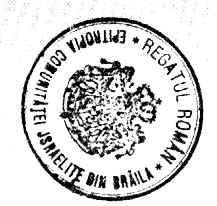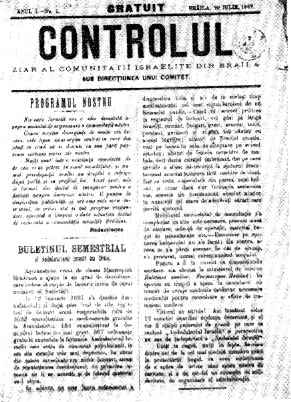 |
 |
The symbol of the Romanian Country is in the center.
[From the collections of the general archives
of the annals of Israel.]
Translator's note: in Romanian
45°16' / 27°59'
Translation of “Braila” chapter from Pinkas Hakehillot Romania
Published by Yad Vashem
Published in Jerusalem, 1969
Acknowledgments
Project Coordinator
Our sincere appreciation to Yad Vashem for permission
to put this material on the JewishGen web site.
This is a translation from: Pinkas Hakehillot: Encyclopedia of Jewish Communities, Romania,
Volume 1, pages 78-88, published by Yad Vashem, Jerusalem, 1969
JewishGen, Inc. makes no representations regarding the accuracy of
the translation. The reader may wish to refer to the original material
for verification.
JewishGen is not responsible for inaccuracies or omissions in the original work and cannot rewrite or edit the text to correct inaccuracies and/or omissions.
Our mission is to produce a translation of the original work and we cannot verify the accuracy of statements or alter facts cited.
(Page 78)
| Year | Number | % of Jews in General Population |
| 1828 | 21 (taxpayers) |
|
| 1831 | 25 ( “ ) |
|
| 1838 | 428 (individuals) |
|
| 1860 | 1,095 | |
| 1891 | 6,752 | |
| 1894 | 8,958 | |
| 1899 | 9,830 | 17.5 |
| 1904 | 10,900 | |
| 1910 | 10,000 | |
| 1928 | 9,270 | |
| 1930 | 7,246 | 8.3 |
| 1941 | 5,119 | 5.1 |
| 1942 | 5,075 | |
| 1947 | 5,960 |
When Brăila became a part of Wallachia through the Adrianopol Agreement
(Page 79)
in 1829, and its port was declared a free port, Jews began to flock to it. They arrived primarily from northern Moldova, from the districts of Botoşani, Dorohoi and Iaşi. In the first censuses from the beginning of the 19th century, Jews who were citizens of foreign countries such as Austria and were exempt from taxes were numbered along with the Jewish taxpayers.
However, the Jewish settlement was not regarded kindly by the local police. They would steal their property and expel them. Intervention and bribes were necessary to allow them to return. For example, in 1837, there were 72 Jewish families in the city, of which only 14 had rights of residency. The rest were expelled by command of the Interior Ministry on the pretext that they were not homeowners.
In 1841, the city council objected to the restrictions that were imposed upon the Jews by the Interior Ministry with regard to rights of residency, on the basis that the city requires trustworthy people of wealth, even if they are of a different religion. The Jews increased in number through the support of the city council despite the fact that the Interior Ministry renewed its restrictions several times.
A command was issued during the regime of Barbu ªtirbei (1849-1853) to cease the expulsion of the Jews.
In 1847, the mayor complained that the head of the district permitted Jews of foreign nationality to settle in the city under pressure of the consuls of their countries. The community, from its side, complained to the authorities that these Jews wish to take over its leadership. At that time, the Ministry of Justice instructed the local court to not permit the purchase of real estate by Jews.
Until the middle of the 19th century, the Jews lived in peace with their neighbors: Greeks, Bulgarians, Lipovans, and a small number of Romanians. During the years 1863-1865, Romanian merchants from Transylvania began to settle in Brăila, and anti-Semitism began to increase.
During the latter half of the 19th century, a wave of Jewish persecution afflicted Romania, including Brăila. The law against peddling that was passed in 1855 and stubbornly enforced affected about 300 Jewish families. The Christian merchants in Brăila presented a petition to their court of law that provided a pretext for the enforcement. The law of the bourses affected a different type of merchant.
At the beginning of the 20th century, the Jews of Brăila formed a large part of the immigration of Romanian Jews to the United States. The Jews who were not affected by the restrictive laws helped those who were to emigrate. In 1903, 439 Jews of Brăila immigrated to the United States. That year, the court imposed a “Jewish oath.” The community refused, and sent a memorandum to all of the communities and rabbis in the country to oppose such an oath. In 1908, the local court once again imposed the “Jewish oath.” Indeed, the city council ordered the closure of the synagogues and forbade the rabbis from participating. The rabbi and the communal leaders were fined and their property seized; however the verdict was repealed after an appeal.
There were 785 Jewish tradesmen in Brăila in 1906 (as opposed to 3,030 Romanians and 1,598 others). The Jewish merchants were occupied in wholesale commerce, and trade in wool, textiles and clothing.
The expansion of the port during the last quarter of the 19th century increased the export in grain, and the Jews began to penetrate into the grain trade which at first was solely in the hands of Greek merchants. This business turned into a bourse game, where the grain prices would rise and fall with respect to prices on the international market. Many Jewish grain traders became wealthy on account of this, whereas others lost their livelihoods. Jewish merchants were forbidden from taking part in the fairs and bourse business. Some of them left the city, and others protested by boycotting the bourse, which immediately felt a reduction in all of its business.
In 1909, the Ministry of the Treasury commanded the tax director of the port to forbid the Jewish officials of the grain trade from appearing in the port. Even the Jewish porters in the port, whose numbers reached 250 at that time, suffered at times from persecution. During the first third of the 20th century, 85 Jewish grain businesses collapsed.
According to communal census of 1915, approximately 50% of the Jewish population were tradesmen, approximately 25% were merchants and practitioners of the free professions, and approximately 25% were temporary workers.
After the guild was abolished, the Jewish community began to become organized. The authorities recognized it and even gave it the rights of trusteeship for inheritances. In 1862, the community was divided due to a dispute that broke out between it and Rabbi Margulies. The meat tax was canceled and the 10-bed hospital was closed.
In 1895, a group of dissidents brought in two shochtim (ritual slaughterers) who sold meat without tax, thereby endangering the existence of the communal institutions. This led to the involvement of the authorities. The Ministry of the Interior issued a directive that only the official community was allowed to accept shochtim. The district leader sided with the community, but the head of the city council sided with the dissidents. Finally, the Prime Minister ordered the city council to refrain from becoming involved with communal affairs, and the district overseer was delegated to carry out the ordinance. A year later, the mayor once again became involved in internal communal affairs, and demanded that he be presented with an annual accounting. In 1899, an 18-member communal council was appointed to oversee the meat tariffs and to collect taxes. The majority of the income was dedicated to the school.
A new style communal council was organized in 1905, through elections. However, already one year later, disputes broke out between the communal leadership and the Chevra Kadisha (burial society). The communal leadership was facing serious budget problems, particularly in the realm of education, and requested that the Chevra Kadisha contribute its portion to this communal budget. However, the Chevra Kadisha refused, claiming that it did not recognize the communal leadership. It disbursed its monies on various buildings, while the schools faced closure due to budget shortfalls. The Chevra Kadisha also controlled
(Page 80)
the baking of matzo, the proceeds of which were generally dedicated to education. 70% of the members of the Chevra were not registered as members of the community and did not pay its taxes.
At a public meeting in 1909, the community declared before all of its members that the Chevra Kadisha would be affiliated with the community, and appointed an eleven-member committee to stand at its helm. This ended the era of disputes, arguments, and mutual accusation between these two central bodies.
|
|
|||
The symbol of the Romanian Country is in the center. [From the collections of the general archives of the annals of Israel.] |
Translator's note: in Romanian |
|
|
|||
ceremony for the Kishinev Pogrom Martyrs [From the collections of the general archives of the annals of Israel.] |
for elections of communal leadership from 1900 Translator's note: In Yiddish. The photocopy is poor and not all letters and words can be clearly made out |
(Page 81)
|
|
of the communal girls' school in 1902 [From the collections of the general archives of the annals of Israel.] |
An old age home was built in 1888, containing 30 beds for the elderly, without differentiating between religion and nationality. 82,000 itinerant poor people were housed in the city between 1888 and 1904. The community set up an infirmary in the middle of the 19th century.
In 1875, the Zion office opened up a four-grade school with 125 students. They were on the verge of purchasing a lot for the building of the school in 1879, but the court refused to authorize the purchase. Only two years later was a building built. It was dedicated in 1882. In 1883, 200 students studied in the school, and in 1890 – 300.
A second elementary school was opened in 1893, called “Chovevei Sfat Kodesh” (Lovers of the Hebrew Language), with 80 students, mostly from poor families. In 1896, the community decided to merge these two institutions.
In 1895, Agudat Am founded a night school for adults in the public school building. It taught foreign languages, as well as science and Jewish history.
In 1897, the Zion office opened a school for girls called Baroness de Hirsch, in which 87 students studied in two grades. In 1903, with the assistance of Y'KA, a building was built for this school.
A kindergarten with Hebrew as the language of instruction was built in 1908.
In 1907, 700 students studied in the community schools, half of them without paying tuition. Hebrew was studied as a living language. That year, a Talmud Torah with 70 students was founded.
In 1910, 563 students studied in the boys school, and 410 in the girls school. That year, 160 boys and 140 girls studied in the public schools.
In 1912, the Al-Yesodi School was founded, with four classes and 130 students.
|
|
|
|
 Yizkor Book Project
Yizkor Book Project
 JewishGen Home Page
JewishGen Home Page
Copyright © 1999-2025 by JewishGen, Inc.
Updated 7 May 2011 by LA